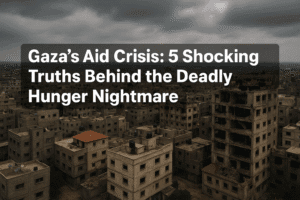Gaza’s Aid Crisis: 5 Shocking Truths Behind the Deadly Hunger Nightmare
Reaching new Israeli-backed aid hubs in Gaza has become lethally dangerous, with Gaza health officials reporting hundreds killed near these sites in the past month. The UN labels the heavily guarded distribution points “death traps,” while the Red Cross confirms treating mass casualties from frequent violence near the facilities, including 19 dead after one recent incident. Desperate Palestinians face an impossible choice: starve or brave potential gunfire and chaos to reach food.
Israel states it fires “warning shots” for security, citing Hamas diversion concerns, but witnesses consistently report troops opening fire on civilians. Meanwhile, catastrophic hunger persists, forcing crowds to ransack UN trucks in the north out of sheer desperation. Aid groups condemn the systemic failure allowing daily casualties, stressing that true safety requires vastly more aid delivered without violence. Civilians like Ahmad Samier Kafina, who “saw death” seeking food for his family, embody the brutal reality of survival in Gaza.

Gaza’s Aid Crisis: 5 Shocking Truths Behind the Deadly Hunger Nightmare
The wrenching image of two relatives embracing over a body near a Gaza hospital bed captures the devastating reality: seeking food has become a lethal gamble for Palestinians. One month after the launch of the Israel-backed “Gaza Humanitarian Foundation” (GHF) aid system, reaching its heavily guarded hubs in southern Gaza carries deadly risks, crippling efforts to alleviate catastrophic hunger.
A System Plagued by Violence:
- “Death Traps”: Gaza health officials report hundreds killed near GHF distribution points over the past month. The UN’s humanitarian coordination agency spokesman, Jens Laerke, starkly labeled the hubs “death traps.”
- Daily Mass Casualties: The International Committee of the Red Cross (ICRC) stated its Rafah field hospital alone activated “mass casualty procedures” 20 times since mid-May. After one recent incident near a Rafah GHF site, they treated 149 patients, including 19 fatalities.
- Contested Circumstances: Witnesses repeatedly report Israeli troops opening fire on crowds approaching hubs. The Israeli military states it fires “warning shots” when people approach “in a threatening manner.” France condemned Israeli gunfire at civilians near an aid point, citing dozens dead and wounded. The GHF denies links to violence near UN convoys and calls allegations false, while the Israeli military denied awareness of the specific Rafah incident cited by the ICRC.
The Roots of Desperation:
- Catastrophic Hunger: “Gaza is the hungriest place on earth,” declares Laerke. Months of severe Israeli restrictions on aid (blocked entirely from March-May) created a famine-level crisis. The UN reports most families survive on one poor meal daily, with adults skipping meals for children and the ill.
- Failed Aid Systems: The GHF system, intended to replace the dismantled UN network and prevent Hamas diversion, operates only a few hubs, primarily in the south. Aid groups criticize it as insufficient and forcing dangerous journeys. Meanwhile, UN deliveries to the north descend into chaos, with trucks ransacked by desperate crowds minutes after entry – a testament to sheer desperation.
- A Cycle of Scarcity & Risk: Ahmad Samier Kafina from Nuseirat embodies the impossible choice: risk death seeking aid or watch family starve. He described walking at midnight, fearing stampedes and theft, facing gunfire, and succeeding only once in securing minimal food. “I saw death there,” he stated, “We have no other source of food.”
Conflicting Narratives & Stalemate:
- Israel’s Security Stance: Israel justifies the GHF system and tight controls, asserting Hamas historically diverted aid. Following reports of Hamas seizing UN aid in the north, Netanyahu and Defense Minister Katz ordered the military to devise a plan within 48 hours to prevent this. Maj. Gen. Yaniv Asor emphasized the war’s continuance: “We cannot tolerate Hamas here… until the threat has been eliminated.”
- Humanitarian Outrage: Aid organizations vehemently reject the violence and systemic failure. ICRC spokesman Christian Cardon condemned “with maximum strength” the daily killings and injuries of people seeking food. The UN accuses Israel of weaponizing aid.
- Political Deadlock: Cease-fire talks remain stalled, hinging on Hamas’s demand for a permanent end to the war versus Israel’s insistence on dismantling Hamas first.
Glimmers and Gaps:
While the GHF reports distributing over 800,000 food boxes and groups like World Central Kitchen resume operations, the scale is dwarfed by need. The UN stresses a “cumulative deficit” after 20+ months of insufficient supplies. More aid enters, yet the fundamental equation persists: obtaining food requires navigating a landscape where violence is routine and starvation is the alternative.
The Human Insight:
This crisis transcends logistics; it’s a profound moral failure. When seeking sustenance means running a gauntlet of potential death, survival itself becomes an act of defiance. The testimonies of people like Kafina, the condemnations from aid workers, and the harrowing casualty figures reveal a population trapped between two existential threats – hunger and bullets. The new aid system, touted as a solution, has instead become a focal point of terror for those it was meant to help.
True resolution demands not just more trucks, but an end to the violence surrounding their distribution and a sustained, unimpeded flow of aid that reaches everyone in need, safely. Until then, the heartbreaking embrace over another body near an aid point remains Gaza’s defining image.
You must be logged in to post a comment.